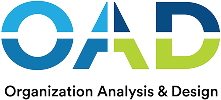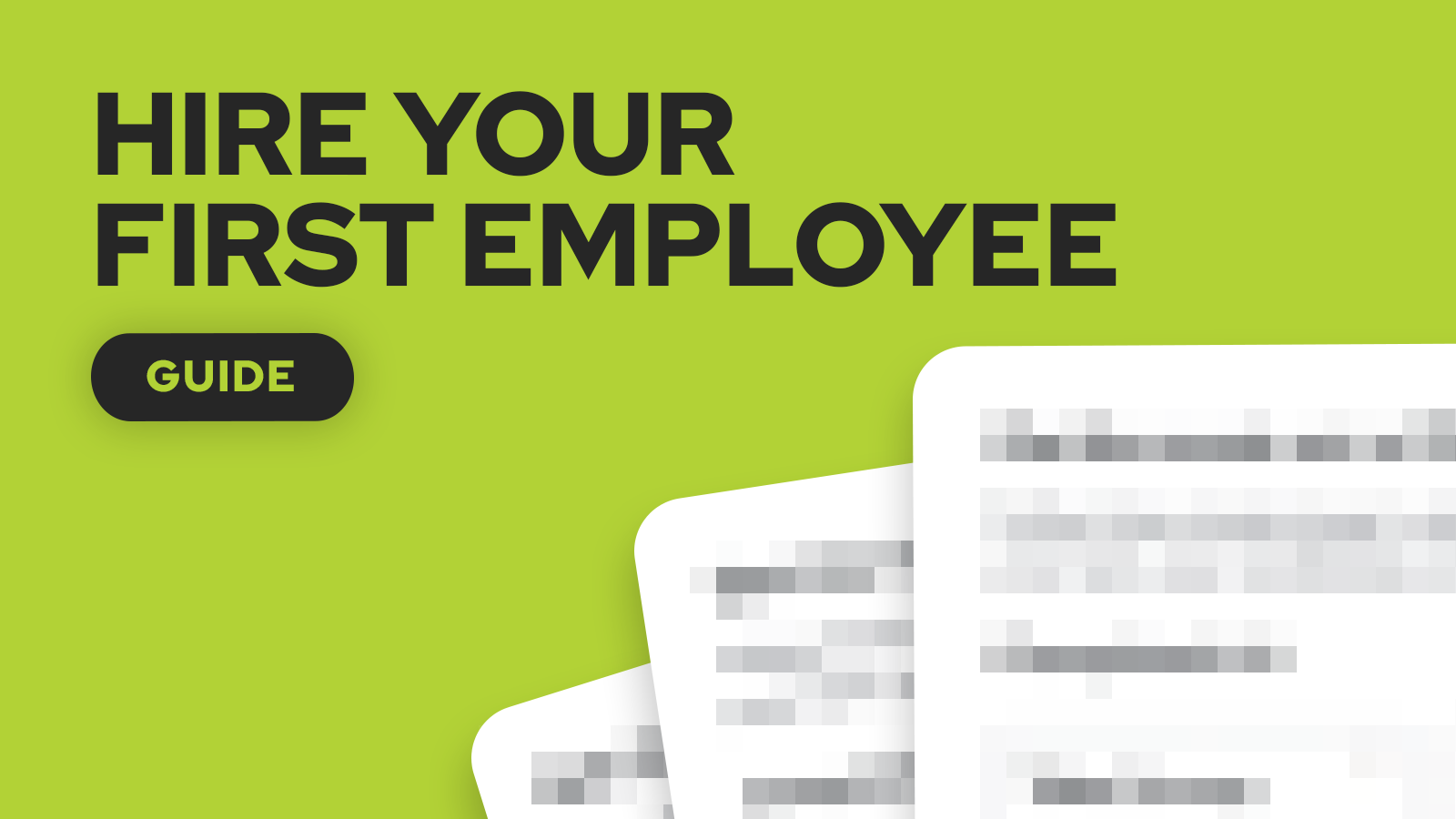Hiring your first employee marks the moment you stop working in your business and start building beyond it. This guide gives you a step-by-step roadmap to hire confidently, avoid costly missteps, and scale with clarity.
Table of Contents
- Why Your First Hire Can Make or Break Your Business
- Step 1 — Understand Your Legal and Administrative Obligations
- Step 2 — Define the Role You Actually Need
- Step 3 — Prepare Your Hiring Toolkit
- Step 4 — Conduct Behavioral Interviews to Find the Right Fit
- Step 5 — Handle Payroll, Benefits, and Legal Forms Correctly
- Step 6 — Create an Onboarding Plan That Sets the Tone
- Step 7 — Think Long-Term: Retention and Growth
- Test for free — Hire Smarter with OAD
- Final Thoughts: Your First Hire Is a Milestone, Not a Transaction
Why Your First Hire Can Make or Break Your Business

Hiring isn’t just about getting help—it’s about setting the tone for your entire company.
For many startups, hiring their first employees is a major milestone that requires careful planning, practical advice, and attention to legal considerations.
Your first employee will shape how you delegate, lead, and grow. The right hire will take ownership, adapt quickly, and bring fresh energy to your business. The wrong hire? They can drain time, misrepresent your brand, and create problems that didn’t exist before.
Many small business owners make the mistake of hiring out of urgency. Without a structured employees hiring process, they’re more likely to encounter misalignment, high turnover, and even legal or financial consequences.
Instead of rushing, treat your first hire as a strategic investment. This is your opportunity to clarify what kind of company you’re building and who belongs on that journey with you.
When you prioritize alignment over speed, you don’t just fill a role—you lay the foundation for long-term success.
Step 1 — Understand Your Legal and Administrative Obligations
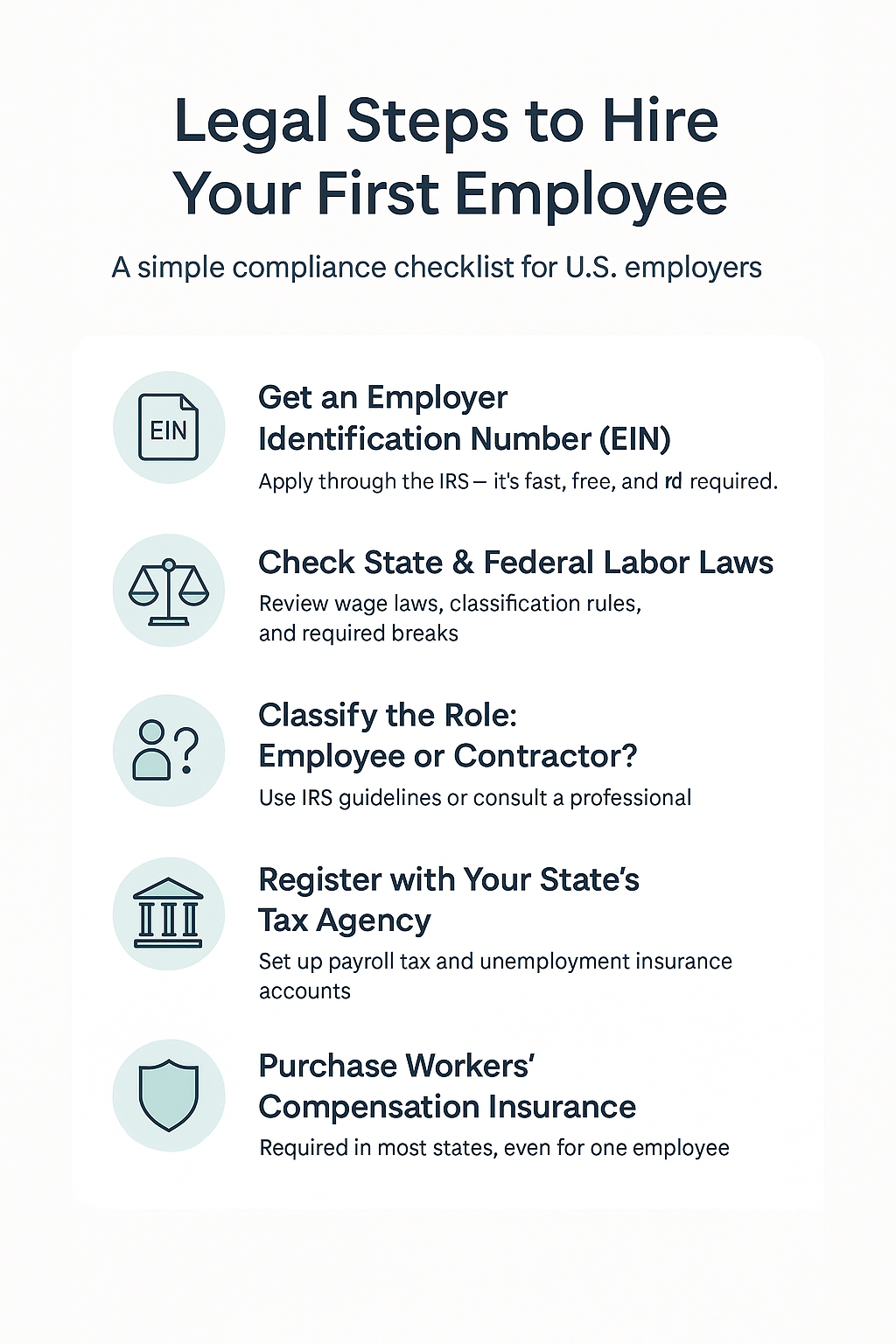
Before you post that job or schedule interviews, make sure you’ve covered your legal obligations as an employer. Employers must meet all federal requirements and ensure compliance with employment laws before proceeding with hiring. Neglecting these steps can lead to hefty fines, legal complications, or even hiring delays. But with a bit of preparation, it’s simpler than you think.
Get an Employer Identification Number (EIN)
This is the business equivalent of a Social Security number. You’ll need an EIN to report taxes and other employment documents. You can apply online through the IRS—it’s fast, free, and essential.
Check State and Federal Labor Laws
Your state may have unique requirements around wage laws, employee classification, breaks, and more. Be sure to check both your state’s labor department and federal labor laws to avoid surprises. A legal professional can help if you’re unsure. For the most up-to-date information on compliance requirements, employers can also visit their state’s official labor website.
Decide: Employee or Independent Contractor?
Don’t just guess—misclassifying a worker can lead to audits and penalties. Use the IRS’s guidelines or consult a tax advisor to determine the correct classification.
Register With Your State’s Tax Agency
Most states require you to register for state payroll taxes and unemployment insurance. Registering with your state’s tax agency is necessary to manage state taxes for your employees. This enables you to withhold the correct taxes and comply with local laws.
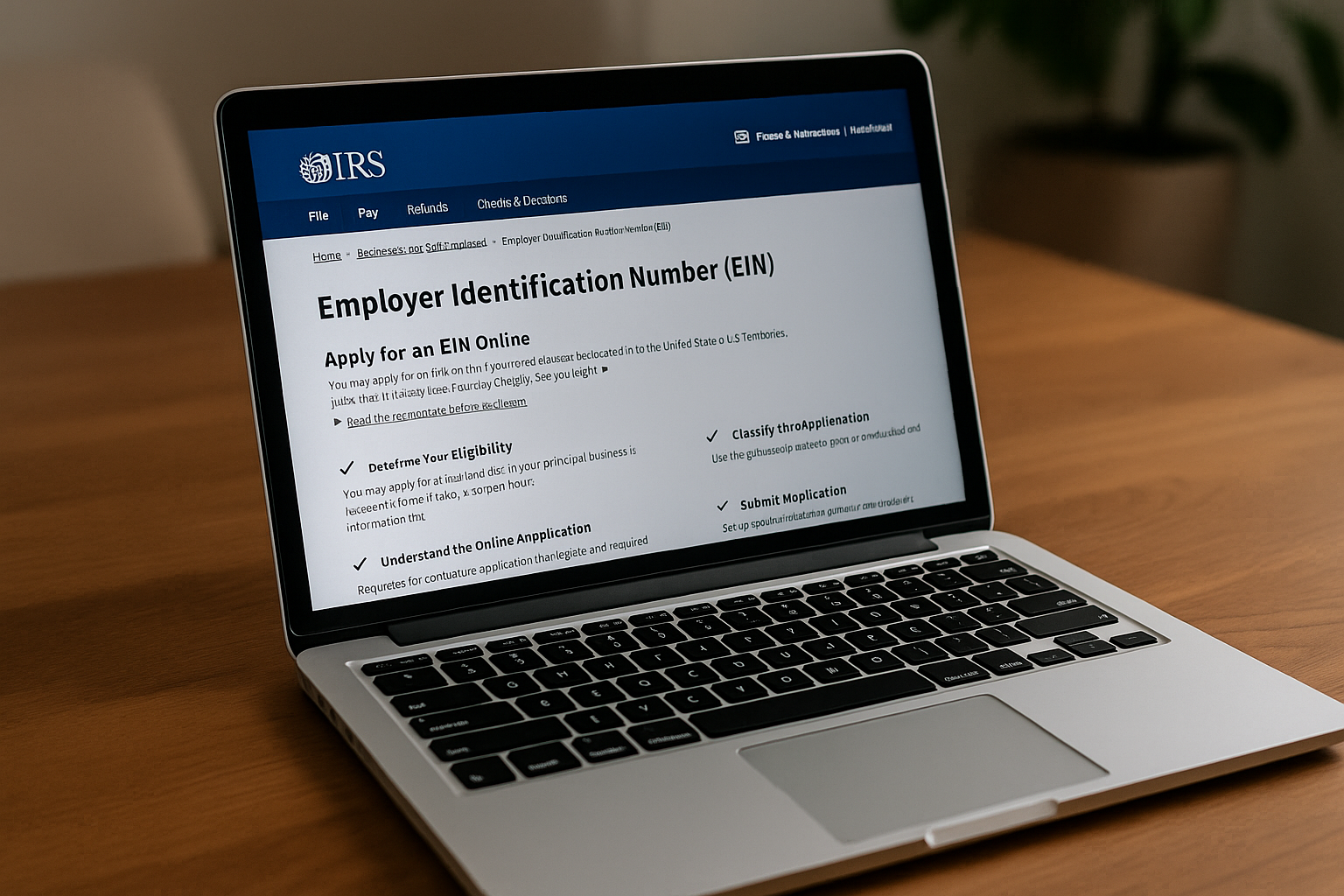
Purchase Workers’ Compensation Insurance
This is mandatory in most states—even for just one employee. It protects you and your new hire in case of work-related injuries. Start with your state’s workers compensation insurance board to compare plans.
Depending on your industry, compliance with health administration regulations, such as OSHA requirements, may also be necessary to ensure workplace safety and meet government standards.
Step 2 — Define the Role You Actually Need
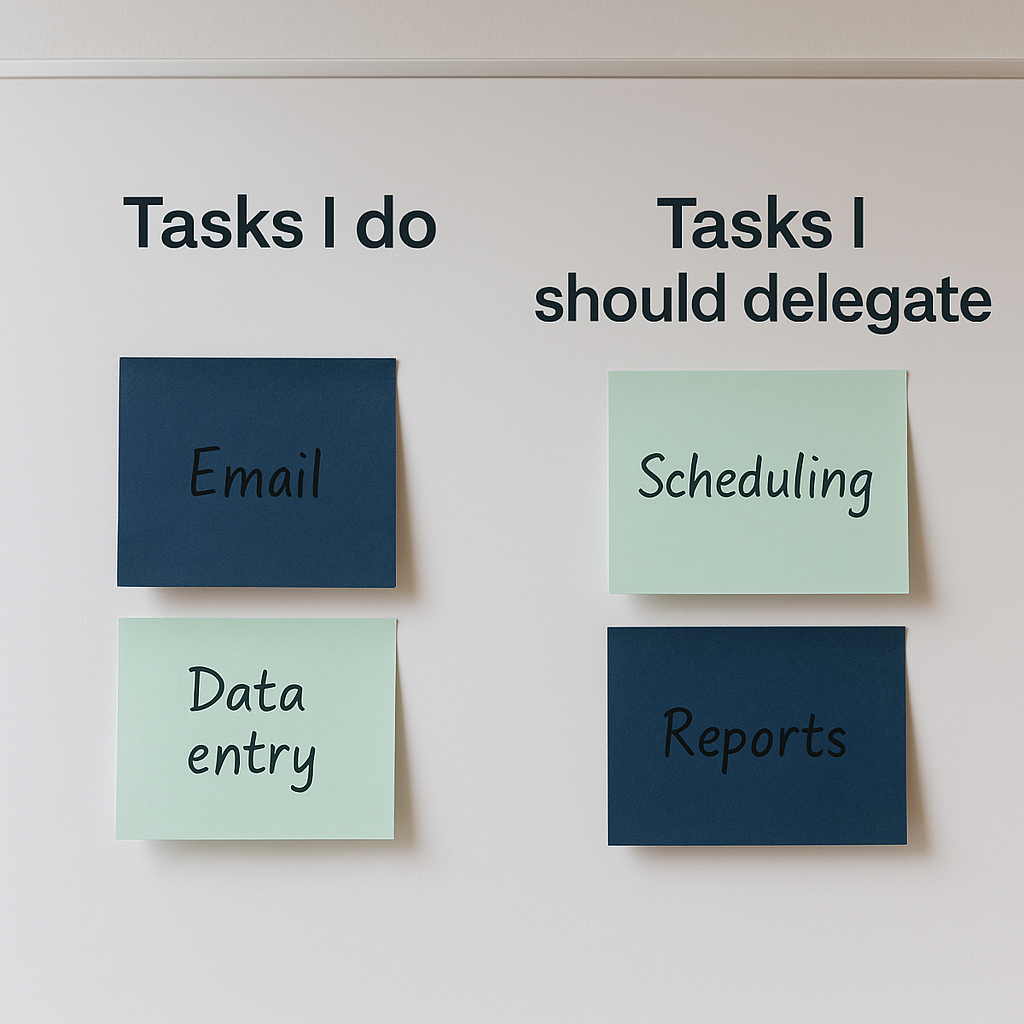
Before writing a job description, get crystal clear on what you actually need help with. Clearly defining jobs helps attract the right talent and ensures your hiring process is focused. Hiring the wrong person isn’t always about their skills—it’s often about hiring for the wrong role in the first place.
Start by asking:
- What tasks take up most of your time each week?
- Which responsibilities drain your energy but could be handled by someone else?
- What’s stopping you from growing faster?
The answers will help you map out the responsibilities of your first employee—and ensure they complement your strengths, not duplicate them. When you’re ready, optimizing your job posting will help you reach qualified candidates, and preparing to manage job applications efficiently will streamline your hiring process.
Clarify Your Business Needs, Culture, and Goals
Do you need a generalist who can handle a bit of everything? Or a specialist with deep expertise in operations, marketing, or admin?
Also consider your company culture:
Do you thrive in a fast-moving startup environment—or prefer a more methodical, steady pace? Your new hire should align with your working style, not disrupt it.

Write a Job Title and Description That Attracts Qualified Candidates
Your job description is your first impression. Instead of focusing only on tasks, highlight:
- The mission behind the role
- What success looks like in the first 90 days
- Growth opportunities for the right person
Small businesses and small companies may need to be especially strategic in their job postings to compete with larger employers and attract top talent.
Avoid vague titles like “assistant” if you need a project manager. Be precise and use keywords that top talent would search for.
Decide on Full-Time, Part-Time, or Contract
If your workload is inconsistent, a part-time or contract role may be a better starting point. Just make sure to classify the role correctly for tax and benefits purposes.
Set a Competitive Salary and Benefits Package
Research what similar roles pay in your industry and region. Don’t forget to factor in:
- Health insurance or stipends
- PTO or holiday benefits
- Retirement plans (if applicable)
- Flexibility and remote options
Offering a comprehensive benefit program can improve employee satisfaction and help attract top talent.
Remember, employee benefits don’t have to break the bank—but they do need to feel valuable.
Step 3 — Prepare Your Hiring Toolkit
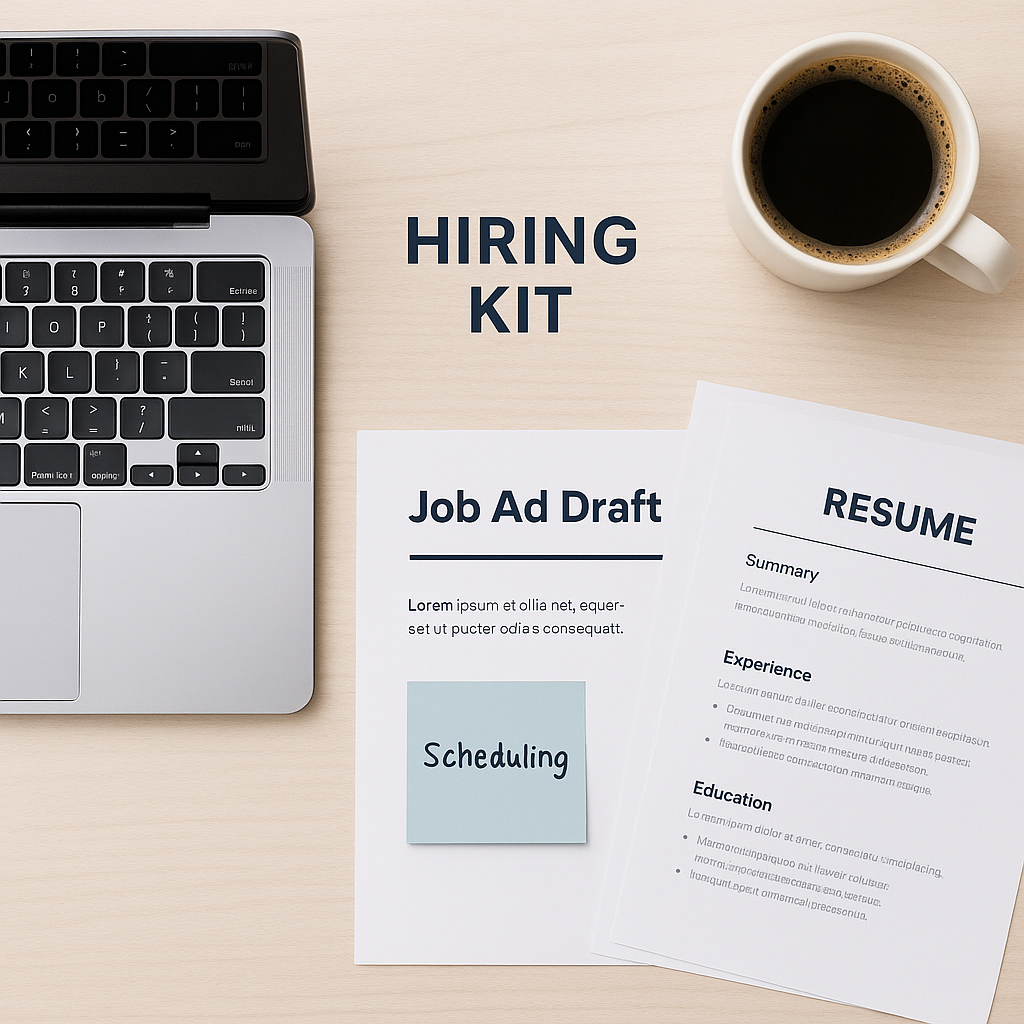
Once you know the role, it’s time to build the systems that will help you find and evaluate the right candidates efficiently. A good hiring toolkit can help you save time by streamlining recruitment and administrative tasks, reduces bias, and increases your odds of landing someone who’s truly aligned with your company.
Choose the Right Job Sites
Posting your opening on a random platform won’t cut it. Think about where your ideal candidate actually spends time.
Popular job sites like Indeed, LinkedIn, or specialized industry boards are a great starting point. But also consider:
- Niche communities
- Slack or Facebook groups
- Referrals from peers in your network
Your goal: go where the right people are already looking.
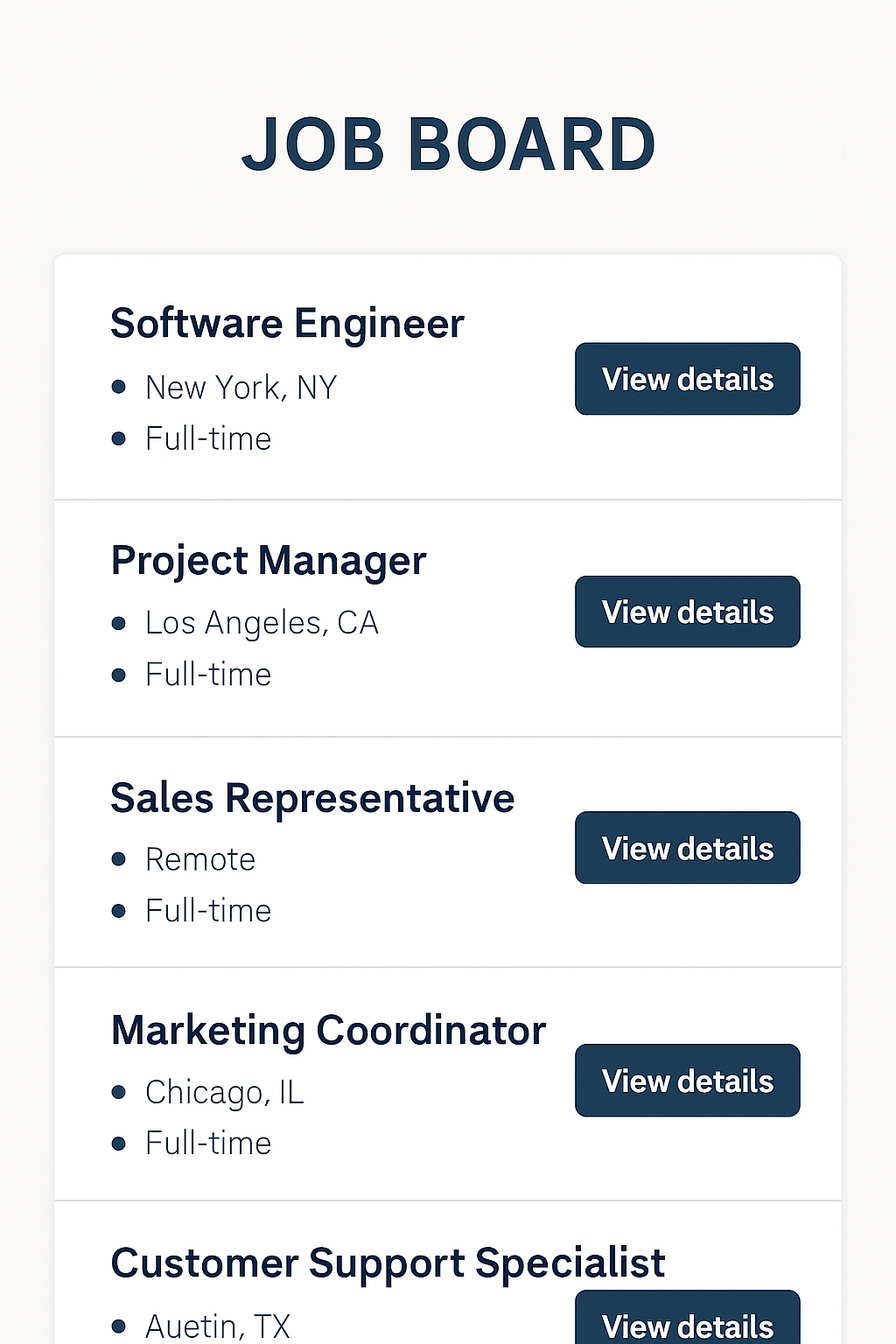
Build a Structured Pre-Employment Screening Process
When you’re hiring your first employee, every interview counts. Without structure, you might rely too much on gut instinct—which can lead to poor decisions.
Instead, create a repeatable screening process:
- Application Review: Efficiently manage job applications to ensure no qualified candidates are overlooked. Look for clarity, relevance, and attention to detail.
- Initial Screening Call: Evaluate enthusiasm, communication, and baseline alignment.
- Skill Test or Trial Task: For technical or creative roles, a short project can reveal far more than a resume.
- Behavioral Interview: Dig deeper into problem-solving style, resilience, and values.
This multi-layered approach helps ensure each potential employee meets both your standards and your style.
Run Background Checks and Verify Eligibility
Depending on your location and industry, you may be required to perform:
- Background checks
- Employment eligibility verification
- Reference checks
It is a legal requirement to confirm each new hire’s eligibility to work in the U.S., typically by completing the I-9 form and verifying supporting documentation. Make sure the new hire’s eligibility is verified through appropriate channels, like citizenship and immigration services or your state’s labor department.
Step 4 — Conduct Behavioral Interviews to Find the Right Fit

When hiring your first employee, it’s tempting to rely on instincts alone—especially if a candidate “feels” right. But chemistry doesn’t guarantee capability.
A behavioral interview helps you see how a person actually handles real-world situations—especially those they’ll face on your team. This approach also helps ensure your new employee will thrive in your business environment.
Ask Questions That Reveal More Than the Resume
Forget generic interview questions. Instead, focus on scenarios that uncover mindset, adaptability, and decision-making. Try:
- “Tell me about a time you had to figure something out without clear instructions.”
- “When have you disagreed with a manager? What did you do?”
- “Describe a situation where you had to juggle multiple priorities—how did you decide what came first?”
These insights will tell you more than any bullet point on a CV.
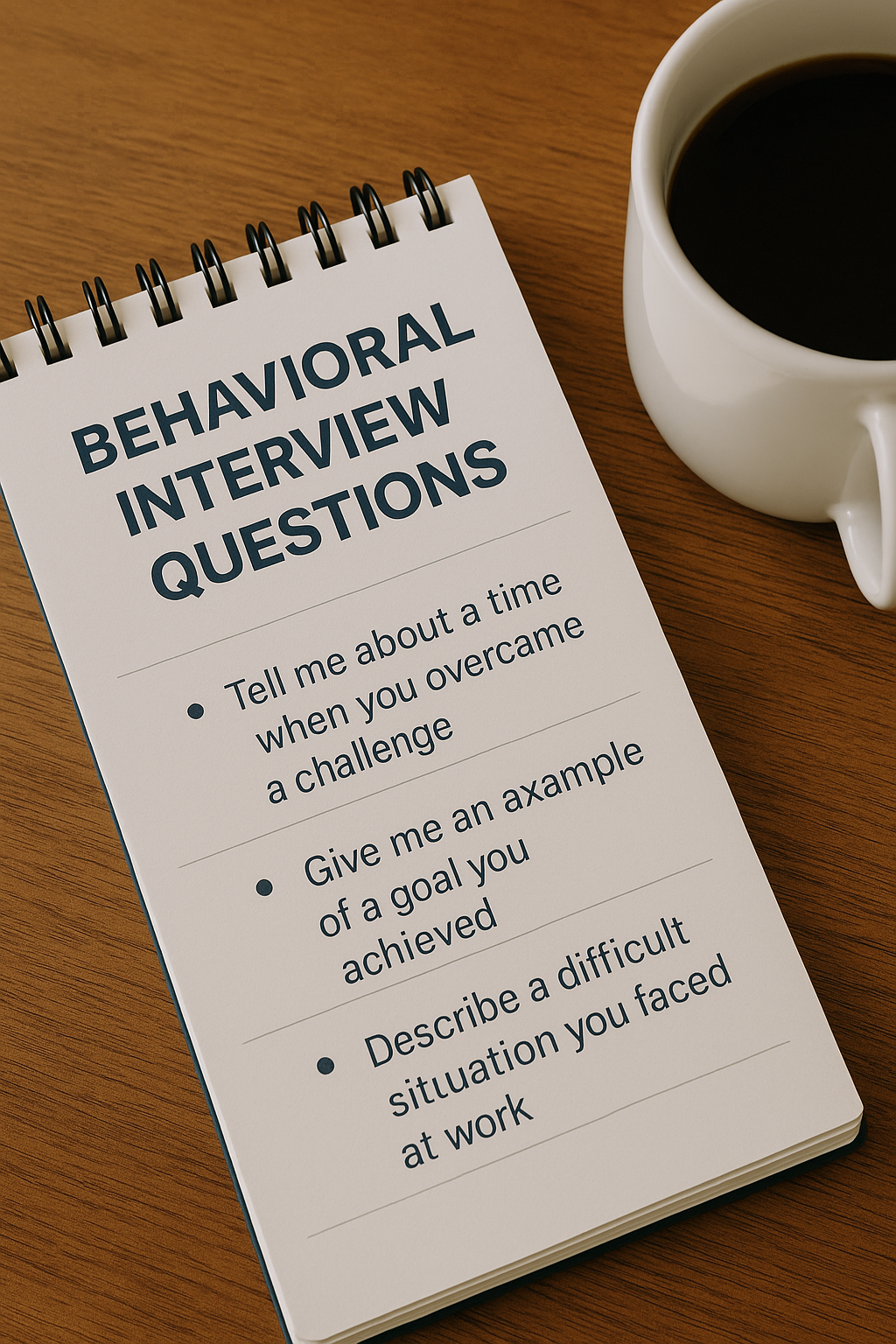
Use Personality Assessments to Go Beyond Skills
Hard skills are easier to measure. But your first hire also needs to be a cultural fit—someone who complements your strengths, not duplicates them.
This is where personality assessments shine. Tools like OAD’s help you uncover:
- Communication style
- Decision-making under pressure
- Natural motivators and blind spots
That extra layer of insight often reveals whether a candidate will thrive—or just survive—in your environment.
Watch for Alignment with Company Vision and Culture
Beyond skill and temperament, ask yourself:
- Does this person want to grow with your company?
- Do they understand your mission—or just want a paycheck?
- Would you trust them to make decisions in your absence?
When it’s just the two of you, alignment isn’t a luxury. It’s a must.
Step 5 — Handle Payroll, Benefits, and Legal Forms Correctly

Once you’ve found the right person, it’s time to transition from “hiring mode” to legal and financial compliance mode. This part may feel intimidating, but it’s easier when you break it down into manageable steps. Paying employees correctly and on time is essential to ensure compliance with federal wage laws and to avoid costly penalties.
Set Up a Payroll System That Works
Even if you’re only paying one person, you need a payroll system that:
- Withholds the correct payroll taxes
- Calculates overtime and minimum wage obligations
- Issues pay stubs or electronic payment records
- Generates year-end tax forms like W-2s or 1099s
Whether you choose software (like Gusto or QuickBooks Payroll) or hire an accountant, this setup ensures your employee’s paycheck is accurate and legal.
Understand Withholding, Tax Reporting, and Insurance
You’ll be responsible for:
- Social Security taxes
- Unemployment insurance
- State and federal tax withholding
- Possibly, garnishments for things like child support
Employers must also report new employees to the state to help locate parents who owe child support, as part of their legal obligations.
Make sure to register with your state’s tax agency and file all new hire reports on time.
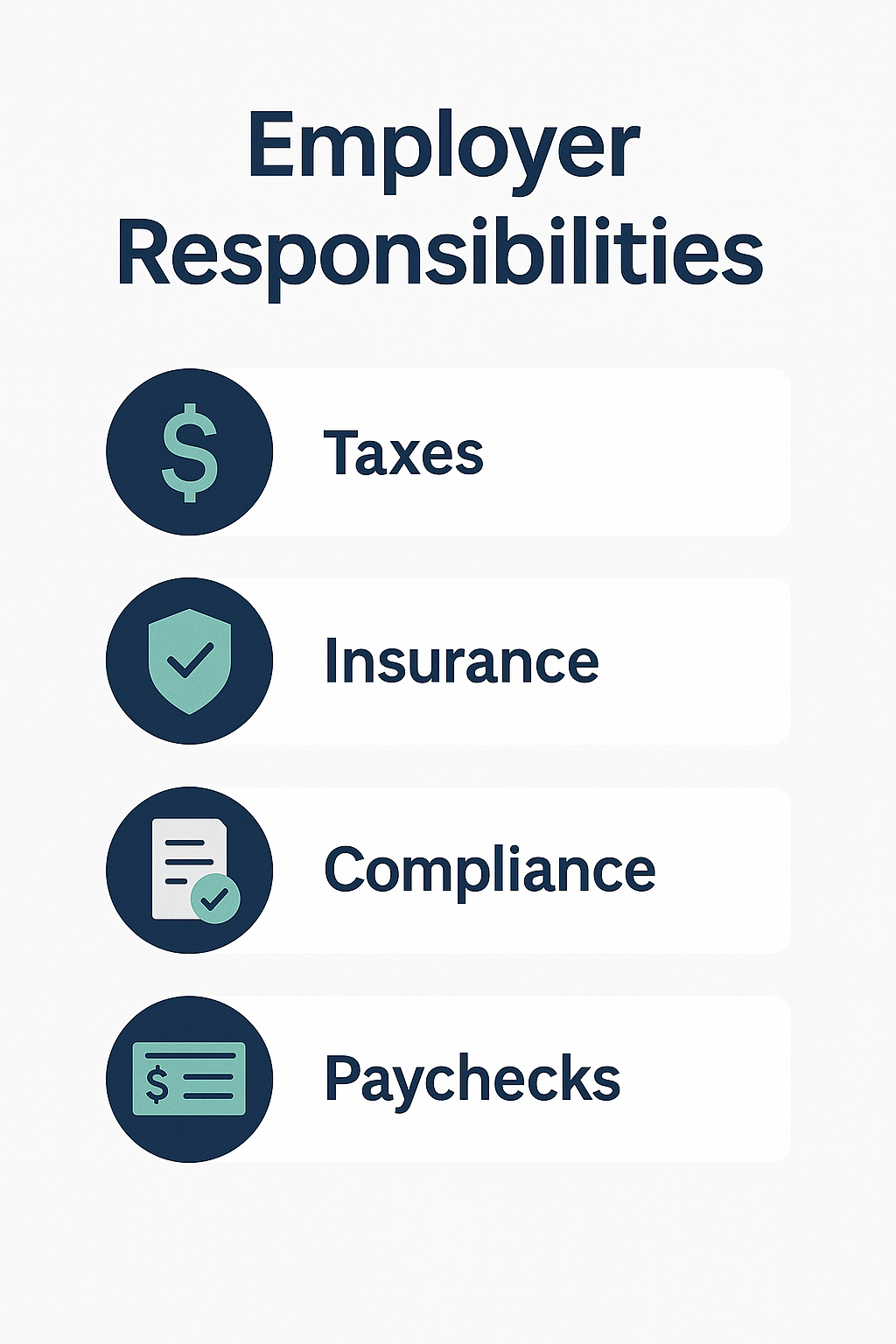
Purchase Workers’ Compensation Insurance (If Required)
Most states require you to purchase workers compensation insurance, even for one full-time employee. This coverage protects both you and your team member if an injury occurs on the job.
Be sure to check with your state’s labor department to confirm your obligations. Some industries (especially those involving manual labor) may have stricter requirements.
Step 6 — Create an Onboarding Plan That Sets the Tone

Hiring doesn’t end with a signed offer letter—it begins with onboarding.
Onboarding is critical for new employees, helping them feel welcomed and informed about your company’s expectations and culture.
Your new employee’s first few weeks will shape how they feel about your company, their role, and their future with you. When onboarding is rushed or unclear, even the best hire can flounder.
Here’s how to set your first employee up for success:
Provide Role Clarity and Expectations
From day one, your new hire should know:
- What they’re responsible for
- What “success” looks like in the first 30, 60, and 90 days
- Who they report to and how they’ll receive feedback
Don’t assume they’ll “figure it out”—clarity builds confidence and autonomy.
Share Your Employee Handbook and Company Values
Even if you don’t have a formal employee handbook yet, you can still share:
- Your company’s mission and values
- Key communication expectations
- How decisions get made
- What to do when something goes wrong
![Photo of a silver laptop on a light wooden desk displaying a branded PDF document titled “Welcome to [Company Name].” The screen shows a section labeled “Our Values” with bolded core values: Collaboration, Integrity, and Innovation, each followed by a short description. A white coffee mug sits to the right and a potted green plant to the left, with soft natural lighting creating a clean, professional, and welcoming workspace atmosphere.](https://www.oad.ai/wp-content/uploads/2025/06/7422fb68-645e-400b-a286-e067f6ee6943.png)
Schedule Regular Feedback and Mentorship Touchpoints
It’s easy to forget follow-up when you’re busy—but without it, new hires often feel lost. Block out recurring time for:
- Weekly check-ins
- Early feedback on projects
- Questions about workflow or tools
- Support with company systems or clients
Make Culture Integration a Priority
Your first employee is more than just help—they’re the start of your team culture.
Simple ways to integrate them:
- Team lunch or coffee outing
- Slack intro with a fun fact
- Shadowing you for a day
- A short video or slide deck about the company’s journey
Those little touches can create big loyalty.
Step 7 — Think Long-Term: Retention and Growth
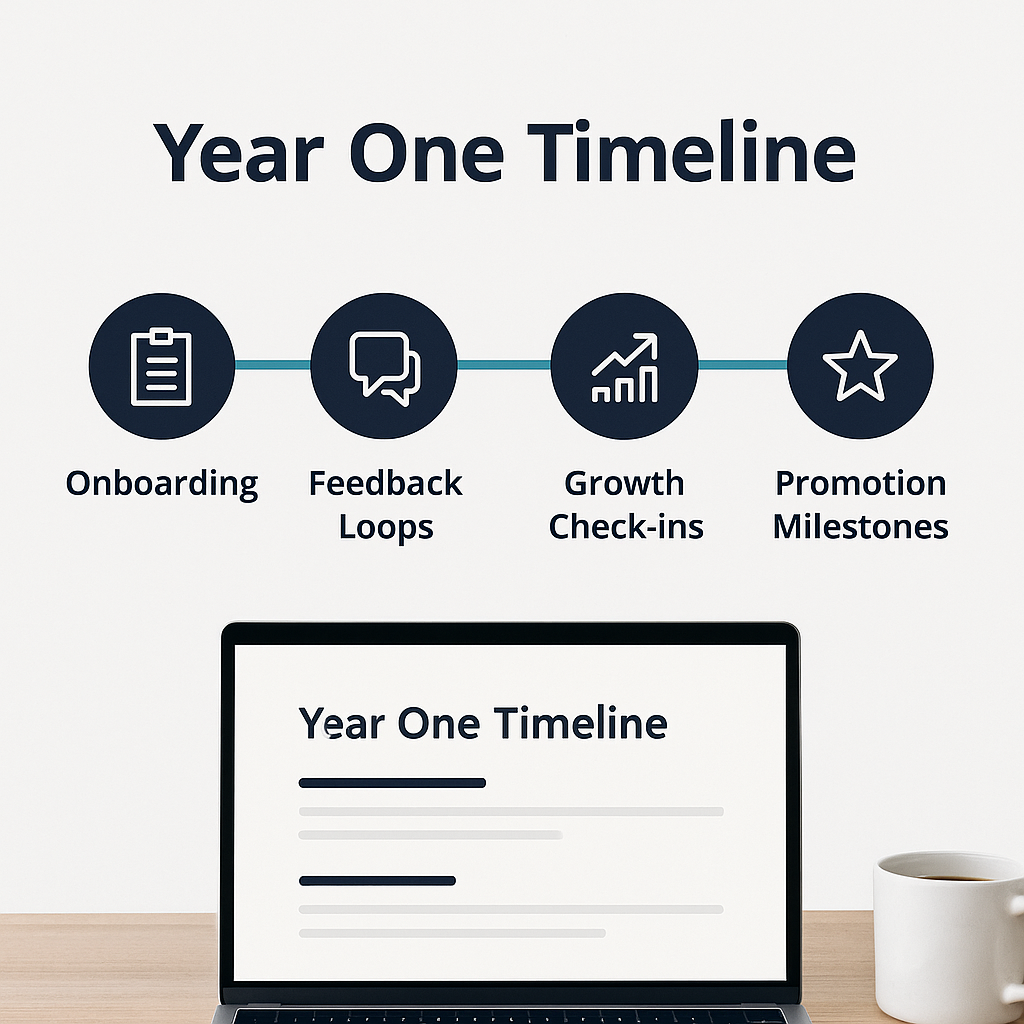
You didn’t hire your first employee just to check a box—you did it to create space for growth.
But growth doesn’t happen by accident. If you want to retain great people and build momentum, you need to be intentional about development, support, and vision. Effective retention strategies also help manage overhead costs by reducing turnover and maximizing the value of each hire.
Track Performance Without Micromanaging
Set measurable goals early on and check in often. This creates alignment, builds trust, and allows you to catch issues before they become problems.
Tip: Don’t just evaluate output—ask what support they need to improve.
Offer Growth Opportunities Over Time
Even if you can’t promise raises or promotions right away, there are many ways to help your employee grow:
- New projects or responsibilities
- Cross-training in other areas
- Access to learning tools or mentorship
- Involvement in decision-making
Investing in their development increases retention and loyalty.

Reassess Hiring Needs as Your Business Grows
Your first hire won’t be your last. Track what’s working, what’s still on your plate, and what your team might need next. As your business expands and you are hiring employees, it’s important to follow proper procedures, such as obtaining an Employer Identification Number (EIN) and ensuring compliance with employment laws. Each time you hire employees, revisit your hiring process to maintain compliance and improve efficiency. Hiring strategically from the start gives you a scalable foundation—not just a temporary fix.
Test for free — Hire Smarter with OAD
Making the right hire is hard enough. But doing it without tools, structure, or insight? That’s a gamble most growing businesses can’t afford.
OAD helps you:
- Go beyond resumes and uncover behavioral fit
- Predict success before you make the offer
- Streamline your hiring process and reduce costly turnover
Whether you’re hiring your first employee or your fiftieth, our scientifically validated assessments can help you hire smarter—starting now.
Test OAD for free today and take the guesswork out of your next hire.
Final Thoughts: Your First Hire Is a Milestone, Not a Transaction
Hiring your first employee isn’t just about delegation—it’s about stepping into leadership. When you approach it with clarity, structure, and purpose, you don’t just grow your business. You build something that lasts.
Take it one step at a time. Use tools that give you confidence. And never forget—you’re not just hiring a worker. You’re building your team.
